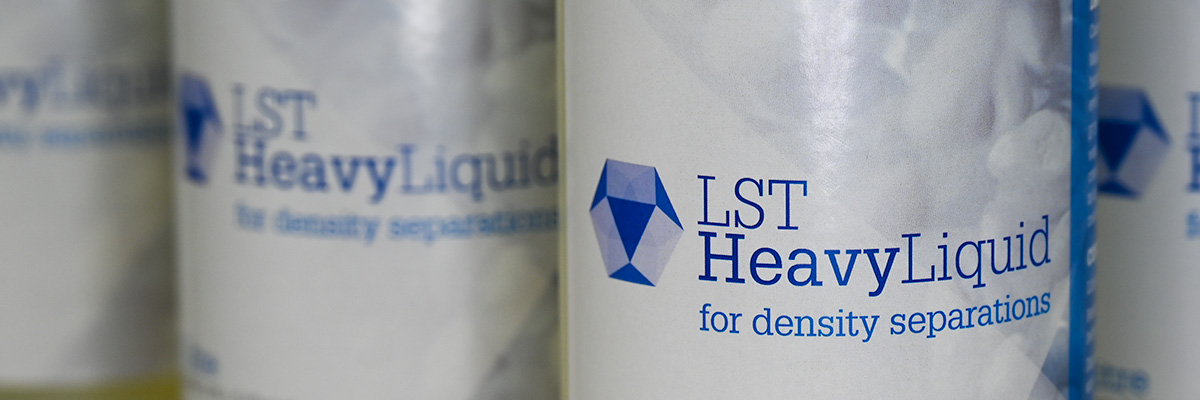
Safe handling, use and recycling of LST Heavy Liquid.
Safety while using LST Heavy Liquid
LST Heavy Liquid has undergone a comprehensive toxicity assessment which has shown it to be of low acute toxicity.
Unlike the organic heavy liquids, LST Heavy Liquid is not an irritant through inhalation, skin absorption or swallowing. However, water proof gloves should be worn during the use of LST Heavy Liquid. LST Heavy Liquid solids are an eye hazard because of their irritancy when allowed to remain in contact with the eyes, and eye protection is required when using LST Heavy Liquid. The lack of vapour pressure for LST Heavy Liquid means that there are no noxious smells and so restrictive use in expensive fume hoods is not required and it does not pose a potential fire hazard.
Using LST Heavy Liquid
LST Heavy Liquids can be stored indefinately in closed plastic or glass containers. The LST Heavy Liquid has a pH of approximately 4. As a consequence LST should not come into contact with metal equipment which can rust, such as iron. Metals such as stainless steel were found to be suitable for short term work.
The maximum density which an LST Heavy Liquid can potentially reach will depend on the temperature at which it is to be used. At 25oC the upper limit of density is 2.96 g/mL. However, to use the liquid at this density would invite problems from crystallisation of LST solids (caused by evaporation or local problems) and higher solution viscosities. A more practical and useful heavy liquid is obtained at a density of 2.85 g/mL, a density similar to that obtained from bromoform. At elevated temperatures densities up to 3.5 g/mL possible (see figure below). As LST is water soluble, the density may be varied by diluting with water, or concentrating by removing water.

For further information on safety aspects of LST Heavy Liquid you can consult the Safety Data Sheet (SDS).
Dos and Don'ts for the safe handling and use of LST Heavy Liquid.
DO
Safety
Wear safety glasses.
Wear rubber gloves if skin contact is possible.
Have clean water on tap to wash any spilt LST off the skin.
Wash your hands after using LST heavy liquid.
Observe good laboratory practice and normal precautions.
Heavy Liquid Separations
Use only plastic or glass containers and implements.
Use only deionised or distilled water to adjust LST heavy liquid.
Use only deionised or distilled water to wash minerals after separation.
Check the density of LST heavy liquid before using.
Clean or deslime minerals before separation with LST heavy liquid.
Keep laboratory temperatures above 20oC to prevent LST crystallisation.
Recycle LST heavy liquid.
DO NOT
Safety
Do not ingest LST heavy liquid.
Do not smoke or eat where LST is used.
Do not allow any LST heavy liquid to contact eyes.
Do not allow regular skin contact with LST heavy liquid.
Do not continue to wear clothing contaminated with LST heavy liquid.
Heavy Liquid Separations
Do not use metal containers, spatulas, or other metal implements.
Do not use saline or contaminated water to prepare LST heavy liquid.
Do not use saline or contaminated water for washing mineral samples.
Do not mix LST heavy liquid with other chemicals or different heavy liquids.
Do not allow LST heavy liquid to come in contact with alkaline materials.
Do not use wet mineral samples, or samples with a high slime content.
Do not allow LST heavy liquid to evaporate, unless the density is rechecked.
Do not chill LST heavy liquid below 20oC. This may cause crystallisation.
Do not discard LST heavy liquid to the environment.
Recycling LST Heavy Liquid
LST Heavy Liquid can be recovered from minerals quite easily by firstly washing the separated minerals with deionised water, filtering, and then concentrating the water washings by evaporation through boiling. The LST Heavy Liquid is not volatile so it is concentrated as the water evaporates. In this way, LST Heavy Liquid can be recycled with greater than 99% efficiency. The overall scheme for use in an industrial laboratory is shown below:

The recovery of LST Heavy Liquid is high by this method. Typically, only 1.5 mL per kilogram of mineral sample of LST Heavy Liquid is lost with general usage.
